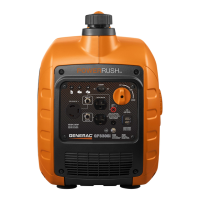
Do you have a question about the Generac Power Systems GP3300i and is the answer not in the manual?
| Surge Wattage | 3300 Watts |
|---|---|
| Peak Watts | 3300 Watts |
| Fuel Type | Gasoline |
| Noise Level | 58 dBA |
| Engine | Generac OHV |
| Engine Displacement | 149 cc |
| Voltage | 120V |
| Frequency | 60 Hz |
| Inverter Technology | Yes |
| Parallel Capable | Yes |
| CARB Compliant | Yes |
| EPA Approved | Yes |
| Type | Inverter Generator |
| Run Time at 25% Load | 8.5 Hours |
| Weight | 59 lbs |
| Outlets | 2 x 120V 20A |
Read this manual thoroughly to understand product operation and safety.
Guidelines and definitions for safety alerts (DANGER, WARNING, CAUTION, NOTE).
Explanation of hazard symbols and their associated risks like CO poisoning.
Hazards related to generator exhaust, carbon monoxide, and proper ventilation.
Risks of electrocution from water contact, wiring, and proper grounding.
Dangers of fuel, vapors, overfilling, and fire prevention measures.
Understanding generator specifications, components, and key features.
Information on EPA/CARB emissions compliance and warranty.
Details on 120V duplex and 30A receptacles for power output.
Functionality of the PowerDial for starting, stopping, and choke control.
Using the 5 VDC USB outlet for charging electronic devices.
How to use the ECO switch for quieter operation and fuel efficiency.
Understanding the meaning of Overload, Low Oil, and Power indicator LEDs.
How circuit protectors prevent overload and how to reset them.
Steps for unpacking and verifying generator and accessory contents.
Procedure for adding the correct type and amount of engine oil before operation.
Fuel requirements, safety precautions, and fueling procedures.
Contact information for questions regarding operation and maintenance.
Essential checks before starting the engine, including oil and fuel levels.
Safety warnings and procedures for preparing the generator for operation.
Explanation of the generator's grounding system and its purpose.
Guidelines for safely connecting the generator to a building's electrical system.
Overview of OSHA regulations, local codes, and utility requirements.
Understanding wattage capacity and avoiding generator overloading.
Proper procedures for transporting the generator without damage.
Step-by-step guide for starting the generator using the recoil starter.
Procedures for safely stopping the generator after use.
Instructions for starting the generator when it is already warm.
How the low oil sensor protects the engine and what it means.
Instructions for connecting two generators for increased power output.
Importance of regular maintenance for performance and longevity.
Recommended service intervals for various generator components.
Routine cleaning and checks to keep the generator in good condition.
General guidelines and recommendations for engine care.
Specifics on oil type, quantity, and maintenance kits for engine longevity.
Procedure for checking the engine oil level before operation.
Step-by-step guide for performing an engine oil change.
How to service the air filter for optimal engine performance.
Checking the muffler and spark arrestor for damage or blockages.
Instructions for inspecting, cleaning, and adjusting the spark plug.
Warning about hot surfaces and inspecting the spark arrestor screen.
Procedure for cleaning the spark arrestor screen.
Importance of checking and adjusting valve clearance for engine life.
General recommendations and precautions for storing the generator.
Steps to prepare the generator's fuel system and engine for long-term storage.
Common causes and corrective actions for an engine that fails to start.
Troubleshooting steps when the engine starts but then stops unexpectedly.
Addressing issues where the engine fails to start or runs poorly.
Diagnosing problems related to the generator producing no AC power.
Identifying and fixing fuel leaks from the carburetor drain hose.
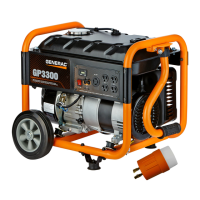
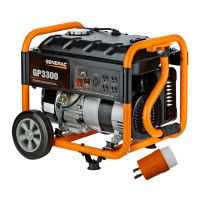

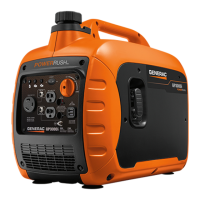
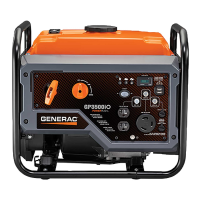
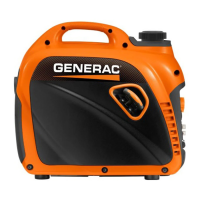
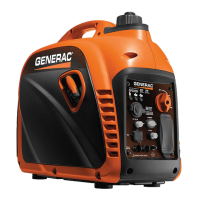

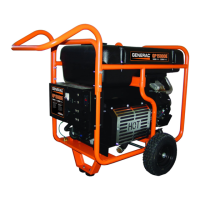
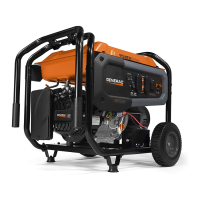
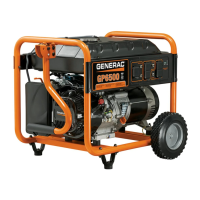
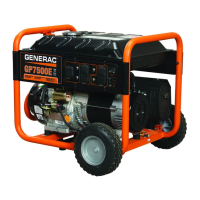
